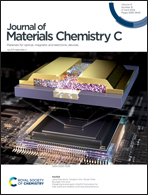The heterostructure topology of a chemiresistive sensor based on hexagonal BaTiO3 and 2D SnO for toluene detection†
Abstract
The SnO–BaTiO3 bi-layered heterostructured chemiresistive sensor exhibits promising potential for detecting volatile organic compounds (VOCs) at room temperature. This study explores the different designs and configurations of a bi-layered heterostructure platform. The performance of the SnO–BaTiO3 sensor was evaluated under humid and VOC atmospheres. The SnO–BaTiO3 bilayer sensor shows a response of 202% at 65% RH and significantly increased to approximately 562% at 95% RH, indicating its sensitivity to both toluene and humidity. The SnO–BaTiO3 device architecture demonstrated excellent repeatability and stability with good response (44 s) and recovery (7 s) times towards the 1000 ppm toluene concentration. For real-time sensing applications, it is essential for the SnO–BaTiO3 bilayer sensor to work reliably at room temperature and to detect VOCs under ambient conditions accurately. It might be used to regulate interior air quality, detect environmental damage, and monitor real-time VOC emissions resulting from industrial activities. Moreover, the bilayer sensor can execute the gas-sensing procedure at room temperature; it can run on a small amount of electricity and consume less energy than conventional sensors.



 Please wait while we load your content...
Please wait while we load your content...